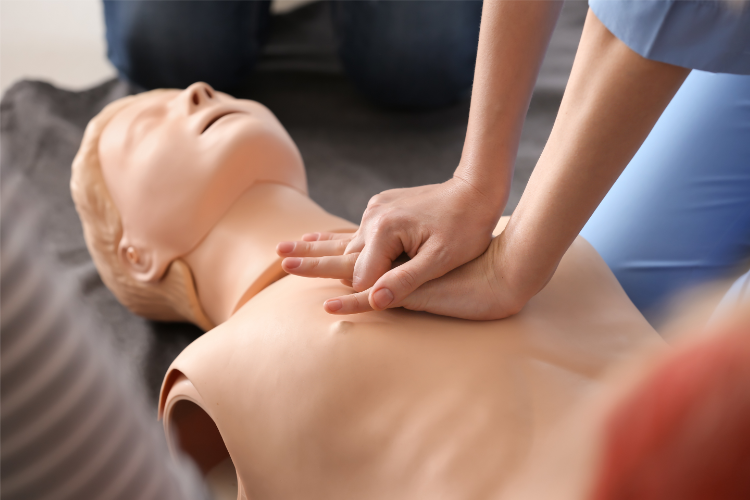Understanding the number and scope of modules in a CPR course for healthcare staff is essential to efficiently plan and maintain compliance with regulatory standards. While some courses may vary depending on the training provider, there is a general outline that most CPR trainings follow, especially those approved by reputable organizations such as the American Heart Association (AHA) and follow the International Liaison Committee on Resuscitation (ILCOR) guidelines. This post explores the typical curriculum and number of modules in CPR training to earn certification.
Types of CPR Certifications for Healthcare Professionals
CPR certifications for healthcare professionals are typically more advanced than those designed for the general public. These certifications often include Basic Life Support (BLS), Advanced Cardiac Life Support (ACLS), and Pediatric Advanced Life Support (PALS). Each of these certifications caters to different emergency scenarios and patient groups. BLS is the foundation, focusing on core life-saving skills. ACLS expands on BLS with more advanced techniques, while PALS is specialized for pediatric patients.
How Many Modules for Each Type of CPR Certification
The American Heart Association collaborates with the International Liaison Committee on Resuscitation (ILCOR) — an organization that publishes evidence-based resuscitation guidelines — to determine which training modules are needed for each type of certification. Here’s a look at the curriculum for each certification training and what the modules will cover, according to the American Heart Association:
- High-quality CPR for adults, children, and infants
- The AHA Chain of Survival, specifically the BLS components
- Important early use of an AED
- Effective ventilations using a barrier device
- Importance of teams in multi-rescuer resuscitation and performance as an effective team member during multi-rescuer CPR
- Relief of foreign-body airway obstruction (choking) for adults and infants
Advanced Cardiovascular Life Support (ACLS)
- Basic life support skills, including effective chest compressions, use of a bag-mask device, and use of an AED
- Recognition and early management of respiratory and cardiac arrest
- Recognition and early management of peri-arrest conditions such as symptomatic bradycardia
- Airway management
- Related pharmacology
- Management of ACS and stroke
- Effective communication as a member and leader of a resuscitation team
- Assessment, approaches, and treatment of systematic evaluation of a trauma patient
- Key concerns during an assessment
- Adjuncts to the primary trauma survey
- Airway obstruction maneuvers and securing the airway
- Identifying shock and providing treatment
- Hemodynamic instability and hemorrhage control
- Trauma resuscitation
- Permissive hypotension
- Massive transfusions
- Traumatic brain injury, burn injuries, and musculoskeletal injuries
Pediatric Advanced Life Support
- High‐quality CPR per BLS recommendations
- Difference between patients who do and do not require immediate intervention
- How to recognize cardiopulmonary arrest early and begin CPR within 10 seconds
- Team dynamics
- DIfference between respiratory distress and failure
- Early interventions for respiratory distress and failure
- Compensated and decompensated (hypotensive) shock
- Early interventions for the treatment of shock
- Difference between unstable and stable patients with arrhythmias
- Clinical characteristics of instability in patients with arrhythmias
- Implementation of post–cardiac arrest management
- Case scenario practices with simulations
How Long Does It Take To Complete All the CPR Training Modules?
The duration of each CPR training depends on a variety of factors, including the type of course, depth of content, how many modules, certification requirements, method of instruction (in-person, blended, or online), the instructor’s approach, and whether or not it is a refresher course or initial certification training. With these factors in mind, the following timeframes generally hold true for completing all modules:
| CPR Certification Type
|
Duration | Method |
| CPR/BLS First Aid
|
4 – 6 hours | In-Person, Blended |
| ACLS (Advanced Cardiovascular Life Support)
|
10 – 16 hours | In-Person, Blended |
| PALS (Pediatric Advanced Life Support)
|
14 – 16 hours | In-Person, Blended |
| Refresher Training
|
Less than 4 hours | In-Person, Blended, Online |
What Happens If Someone Fails a CPR Certification Test After Completing the Modules?
If someone fails a CPR certification test after completing the training modules, they typically have options to retake the test. Training organizations usually have policies in place to address such situations. The retake policy can vary; some providers may allow an immediate second attempt, while others might require a waiting period or additional training. When the training is offered by a healthcare organization — the individual’s employer — the option to immediately retake the test can also depend on the organization’s specific company policies. Ultimately, the objective is to ensure that all staff who receive certification gain the necessary skills and knowledge to perform CPR effectively and confidently.
Tailored CPR Training for Your Staff
Implementing quality CPR training for your staff with all the required modules is certainly a proactive step towards preparedness and compliance. Training your employees in CPR equips them to handle emergencies effectively and save lives. It goes without saying, but providing CPR training for staff undoubtedly reflects positively on your organization’s commitment to safety and employee development. Learn more about how to tailor CPR training to the needs of your staff.
